How to lose a stone in a month - an effective plan for healthy, sustainable weight loss
Nutritionists, PTs and dietitians reveal how to lose a stone in a month safely, with healthy and sustainable methods that stand the test of time
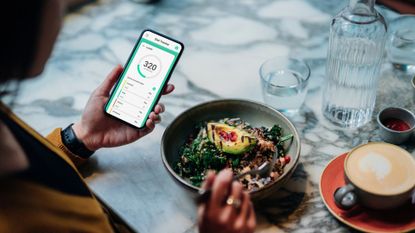

Before we dive into how to lose a stone in a month, it's important to remember that safe, healthy and sustainable weight loss methods will always be the best way forward. You can lose weight quickly but if you set your goals too high and restrict yourself too much, you'll likely gain it back even faster.
There's no denying that losing a stone in just four weeks is a big goal - that's 14 pounds overall. This is a much higher goal than many health organisations, including the NHS, would suggest is healthy to lose in this time frame due to the potential side effects. If possible, try to give yourself more time and if you are going to change your eating and exercise routine dramatically, always consult your doctor first.
If you want to lose weight quickly, without making big weight loss mistakes, a calorie deficit will be essential alongside a steady intake of protein-rich foods and regular exercise. Whether you want to lose weight in a month or learn how to lose weight without dieting, we've got advice from several personal trainers, doctors, and nutritionists to see you through the process.
Can you lose a stone in a month?
Yes, you can lose a stone (14lbs) in a month with changes to your diet and exercise routine, says Dr Thais Aliabadi, a board-certified physician specialising in weight loss. "But losing that amount of weight in such a short period is not necessarily safe for everyone. It's equivalent to losing three and a half pounds per week."
The NHS suggests a maximum weight loss goal of one to two pounds per week, working out to an 8lb of weight loss in a month at most. This is a much more sustainable approach to weight loss and it avoids the pitfalls of quick-fix diets that promise weight loss over a short amount of time.
These diets, also known as 'fad' diets, don't work. "You will not be able to sustain your normal way of living on these diets," says weight management nutritionist Jess Hillard. "Your body craves the things you've cut out, you give in, eat more, and then the weight will go back on again. Even if you return to regular eating habits after the diet, you'll gain weight back. Then tends to begin a dieting cycle, which doesn't work either."
When taking on one of these 'quick-fix' diets, at the beginning, you'll lose water weight rather than actual fat. As these diets are often so unsustainable, you're unlikely to keep it up for long enough to see any actual fat loss. If you do, you'll likely lose muscle and fat, says weight management nutritionist Jess Hillard, which is not ideal.
Sign up for the woman&home newsletter
Sign up to our free daily email for the latest royal and entertainment news, interesting opinion, expert advice on styling and beauty trends, and no-nonsense guides to the health and wellness questions you want answered.
"[Losing muscle] can harm your metabolism permanently, as the amount of energy your body needs daily is determined by your lean muscle mass. This can make it harder for you to lose weight in the future. Not to mention, it'll put you at risk of developing a nutrient deficiency as you won't get enough vitamins and minerals, including vitamin C, magnesium, and iron," says Hillard, the resident nutritionist at Warrior.
That being said, it is possible to lose 3.5 per week, working out to one stone per month. If you're looking to know how to do it safely and sustainably, here's what the experts suggest...
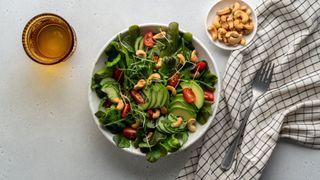
Opting for foods rich in protein, complex carbohydrates, and healthy fats are lower in calories and keep you full.
How to lose a stone in a month
1. Find your calorie deficit
If you want to learn how to lose a stone in a month, you have to put yourself into a calorie deficit. While there are many ways to do this, from simple restriction diets to plans like the keto diet that restrict higher-calorie nutrients like carbohydrates, it's the only way to start losing weight.
As several institutions, including the University of Athens and Colorado State University, explain, a calorie deficit is when you burn more calories than you eat every day. This calorie burn comes from exercise - but mostly it comes from the everyday processes our body goes through, such as sleeping, sitting down, and even eating. This is known as your resting metabolic rate (RMR) or resting energy expenditure (REE). It also comes from non-exercise movement, known as non-exercise thermogenesis (NEAT) - activities like walking around the house, taking the dog out, and gardening. Anything that isn't heart-rate-raising exercise.
These together work out to almost our entire daily calorie burn. This number, combined with the calories you burn from exercise, has to be more than the calories you eat to lose weight.
Use a calorie calculator to work out your resting energy expenditure and calorie deficit based on your height, BMI, and activity levels.
How big should the calorie deficit be to lose weight? While evidence shows that the deficit can be as small as 250 calories a day, to lose a substantial amount of weight healthily, research from Soonchunhyang University Gumi Hospital and Monash University shows it should be around the 500 to 750 calorie mark.
2. Have a protein-rich breakfast
Having a breakfast rich in the best high-protein low-calorie foods will keep you fuller for longer as protein is one of the most filling macronutrients, research from Purdue University explains. Doing so, nutritionist Kim Pearson explains, "will in turn help prevent mid-morning snacking as you'll be fuller through the day, keeping your calorie count lower."
A high protein breakfast also promotes weight loss by regulating our appetite hormones, ghrelin and leptin, she explains. "Swapping cereal or white toast for a protein-rich breakfast of eggs on granary bread or porridge with a dash of high-quality protein powder is the way to go if you want to know how to eat less in the morning and stick to your calorie deficit."
As well, when we exercise, we put a strain on the muscles so eating enough protein is essential for this too. If you're short on time, this could be in the form of your best protein shake for losing weight. Otherwise, including high-protein foods in your diet will do the trick.
"Protein is key to help rebuild muscle fibers. Lean meats like chicken, dairy sources including eggs and milk, alongside powders and supplements are a great way to include the nutrient in your diet," Hillard says.
3. Fill your plate with vegetables
The same research from Purdue University says that alongside protein, fibre is a great macronutrient to help you stay full. Present in high-fibre foods including vegetables like leafy greens, incorporating more of these into your diet will help you stay in your deficit.
"Carbohydrates are converted to sugar in the body and if these sugars aren't used for energy, they're likely to get stored as fat," says nutritionist Pearson, "Avoid foods like white rice, pasta, noodles, and bread. Cauliflower rice and courgette spaghetti make great alternatives to your standard rice and pasta."
Pearson suggests that at least half your plate should be vegetables - ideally green leafy vegetables and low-carb vegetable options, such as spinach, kale, mushrooms, and tomatoes. A quarter should include high-fibre foods like whole grains and wholewheat alternatives to refined carbs. The other quarter should be protein, like white meats, beans and legumes, or soy alternatives like tofu.

4. Add good fats to all your meals
Pearson insists it's imperative to eat fat if you want to learn how to lose a stone in a month, contrary to what you might have previously been told. "You might think that it could lead to gaining weight, but the opposite is true," she explains. "Fat is not only essential for health, but numerous studies have shown that a diet lower in carbs but higher in healthy fats is the best and quickest way to lose weight."
What does that include? "Good fats can be found in oily fish, nuts such as walnuts, and seeds like flaxseeds and chia seeds," adds Pearson. "Aim to include a moderate portion of healthy fats, along with some of the other best foods for weight loss, at every meal."
The ketogenic diet is a popular form of this low-carbohydrate, low-fat eating style you may have heard of before. While it does have merits and works for some people, it won't work for everyone. "It's not a long-term option in my opinion as side effects of this and similar plans include the aptly-named keto headache, mental fogginess, and irritability," the nutritionist adds.
5. Keep an eye on portions
"My favorite way of checking meal size is by using your hands," recommends Hillard. "Is there one thumb of healthy fats? One fist of carbohydrates? One palm of protein? Two fists of vegetables? This not only ensures the plate is a balanced meal, but it will help to keep you satisfied with each meal, ensuring you are not snacking on unhealthy options throughout the day."
If you're struggling with portion control, and have the means to do so, utilising one o the best weight loss meal delivery services or recipe boxes can be a good plan at the beginning of your weight loss. Many subscription services offer lower-calorie alternatives to go-to dishes and they can save time and money by delivering all required ingredients to your front door. When you're finished, you can reuse the recipe cards with your ingredients and make them again.
6. Make time for regular exercise
As discussed, exercise is crucial to losing a stone in a month - or any amount of weight. "Food makes a massive difference, but exercise is also vital," says Hillard. Along with helping you burn more calories, exercise like strength training will help increase your muscle mass, contributing to a faster metabolism and can make weight loss easier.
"Increasing muscle mass will enable the body to burn more calories by increasing the metabolic rate, which increases the number of calories you burn at rest," she says. "Raising your heart rate slightly will also help reduce the risk of conditions such as type 2 diabetes and cardiovascular disease."
Strength training, often called resistance training or weightlifting in some cases, is using machine and hand-held weights as resistance while you complete bodyweight movements. You can do strength training at home for beginners, with one of the best strength training apps, or you can do it at the gym, it doesn't make much difference.
High-intensity interval training, better known as HIIT, can be helpful for this, with studies from the University of New South Wales showing that these activities burn more calories over time than many cardio workouts, for instance. But it's not suitable for everyone. For example, those going through perimenopause and who are postmenopausal may find multiple HIIT sessions elevate their cortisol levels too much.
For those looking for something a little more low-impact, the 25-7-2 StairMaster workout, walking, hiking, and light jogging are good alternatives. "Start with a 30-minute walk per day, at least three times a week," suggests Dr Aliabadi, who works with Trimly.com. "Then gradually increase your time and intensity."
Don't enjoy exercise or find it boring? "Joining gym classes or exercise groups can be a great way to meet people and spice things up exercise-wise," adds Hillard. "For instance, one of the many benefits of swimming is that it's sociable with many swimming clubs around the country, but it also creates minimal impact on the limbs."
However, the important role of exercise in weight loss is another reason why it's important to learn how to lose a stone in a month slowly. If you're new to exercise and suddenly start without easing yourself in when trying to burn calories to lose weight, you could injure yourself, meaning you won't be able to exercise in the coming weeks at all.
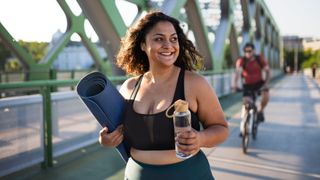
7. Move whenever you can
To burn more calories, try moving a little wherever you can. Non-exercise activity thermogenesis (NEAT) is another important way we burn calories, as noted.
It includes all the movement outside of voluntary exercise we do, such as moving around the house, walking the dog, and standing up when cooking in the kitchen. This NEAT calorie burn, combined with calories burned during exercise and the calories burnt at rest, must be more than the calories you eat to lose weight.
Find small pockets of time in your day for this movement - you don't need to move all the time. "If you're deciding between jumping in the lift or taking the stairs, then the latter is always the smarter choice," says Hillard. "Keeping your body moving will have a massive impact on your weight loss journey and general health. Walking for weight loss is a form of cardio, for instance, and cardio burns calories. Even at home, walking up and down the stairs a couple of times throughout the day will play a part."
8. Try to avoid grazing
"It's better to eat substantial main meals and then allow time in between," Pearson explains. "This lets your body use up some of your stored fat reserves, rather than purely focussing on easy energy from the food you've just consumed."
Three meals per day should suffice, she says. "While this does depend on the individual, for the average person who isn't following an intensive exercise program, eating three meals per day five hours apart is ideal. For example, you might have breakfast at 9 am, lunch at 2 pm, and dinner at 7 pm. It's also a good idea to avoid eating late at night."
However, if you are not new to exercise and have increased how often you work out, snacking may be essential to maintaining your energy levels. Opt for high-protein snacks and protein shakes to feel the full benefits of protein powder for satiety, and choose carbohydrate-based snacks that are quick to digest like bananas.
9. Reconsider your alcohol order
We live in a very alcohol-focused society and when it comes to learning how to lose a stone in a month, drinking calories is many people's biggest problem. "Alcohol can contain high amounts of sugar and it increases our appetite hormones, compromising willpower when it comes to food choices. The following day, those who have been drinking can suffer from a 'sugar hangover' which makes them crave high-carbohydrate and fatty foods, like takeaway. This, of course, does not contribute positively to a healthy calorie deficit," says Pearson.
It may be more about cutting back and finding suitable alternatives to alcohol you enjoy instead if you have a healthy relationship with alcohol and practice mindful drinking. Otherwise, this may be a good time to reassess your relationship with alcohol and seek from your doctor.
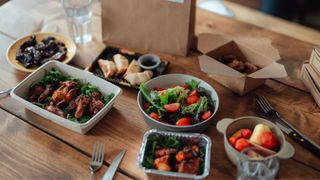
10. Don't deny yourself treats
Rather than heading straight to the advice on how to stop eating chocolate and other sweet treats for good, enjoy them in moderation. It's important to indulge yourself every now and again, even when you're sticking to a tight calorie deficit.
"Cutting out everything you love is likely to end up making you miserable," says Pearson, and we couldn't agree more. Moderation is key when it comes to weight loss because for an eating regime to be effective it needs to be something you can stick to.
"Allow yourself one treat meal per week where you can eat whatever you fancy, suggests Pearson. Or, spread them out over the week. "Having a piece of chocolate each evening is a balanced way of enjoying it," adds Hillard. "There's no such thing as healthy chocolate but try and choose dark chocolate which contains less sugar and has the additional health benefits of flavonoids."
11. Beware of hidden sugars
"Consuming too much sugar is one of the main ways weight loss is stalled," says Pearson. "If it's not used immediately for energy, like exercise, the body will convert it to fat to store for future use."
While we all know that biscuits, cakes, chocolate and sweets are high in sugar, there are some foods with hidden sugars that you need to watch out for. "You might be surprised, but you'll find them in cereal bars, stir fry sauces, salad dressings and smoothies," says Pearson. "Check the nutritional information to find out how much sugar is really in your food, and if in doubt, consume real fruits or make your own sauces and salad dressings."
There are some other additives to note, especially if a product is labeled as low fat or low sugar. "In order to make these ‘low’ they add in additional ingredients," warns Hillard. "These can include artificial ingredients such as xylitol, which can have health consequences. Often full-fat versions are actually best."
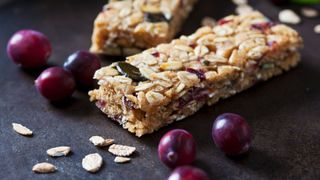
12. Limit processed foods
There's been a lot of talk about ultra-processed foods (UPFs) recently. These industrially processed foods contain ingredients we wouldn't use at home, such as preservatives, artificial colours, sweeteners, and emulsifiers. You might think you don't eat any of these - but basic food staples like store-bought sliced bread can count among them.
Typically, according to a recent report published in The Guardian, our diets are about 80% UPFs and they are linked to several serious health issues. When it comes to weight loss, UPFs can contain ingredients that increase levels of ghrelin in the body - the primary hunger hormone - and make us feel hungry. They also tend to be richer in sugar and salt - two ingredients that taste great, so we want more of them.
Together, this can lead to overeating that quickly pushes you out of a calorie deficit.
13. Keep track of your calorie intake and burn
When it comes to sticking to a calorie deficit, one of the top tips recommended by all the experts is to track what you eat via one of the best calorie-counter apps. These allow you to log calories and nutritional information like protein intake and offer a daily total.
"I recommend using MyFitnessPal to record what you eat," says Pearson. "This is useful in identifying unhelpful behaviours and foods you might think are healthy but discover aren't." It can also help you avoid nutrient deficiency since you're given a breakdown of your vitamin and mineral intake.
However, much like anything else when it comes to learning how to lose a stone in a month, it won't be an option suitable for everyone - especially those with a prior history of disordered eating - so it's important to assess other options too, such as the 80/20 method.
Does drinking water help you lose weight?
Yes, drinking water can help with weight loss. It increases your resting energy expenditure (REE) by up to 30% within 10 minutes of drinking, according to research from Humboldt University, and this is a benefit that lasts for up to an hour.
Regularly drinking water, studies of middle-aged and older people by Virginia Tech have found, is a good appetite regulator as it works to combat dehydration, which is sometimes mistaken for hunger, and it takes up space in the stomach which can help with feelings of fullness.
Water is also a winner as a replacement for high-sugar drinks like soda or alcoholic beverages since it doesn't have any calories.
However, water should never be used as a replacement for food by those looking to learn how to lose a stone in a month. As all the nutritional advisors have said above, reducing calorie intake excessively has numerous negative side effects including short-term symptoms like binge eating, headaches, nausea, and fatigue, alongside longer-term issues such as nutrient deficiencies and a slower metabolism.
For more effective and longer-lasting results, approach weight loss sustainably by making gradual changes to your diet and exercise routines, and always consult a health practitioner if you're unsure of the best way forward.

Grace Walsh is woman&home's Health Channel Editor, working across the areas of fitness, nutrition, sleep, mental health, relationships, and sex. She is also a qualified fitness instructor. In 2024, she will be taking on her second marathon in Rome, cycling from Manchester to London (350km) for charity, and qualifying as a certified personal trainer and nutrition coach.
A digital journalist with over six years experience as a writer and editor for UK publications, Grace has covered (almost) everything in the world of health and wellbeing with bylines in Cosmopolitan, Red, The i Paper, GoodtoKnow, and more.
-
 Don't love overly Christmassy nails? These black manicures are chic *and* subtly festive
Don't love overly Christmassy nails? These black manicures are chic *and* subtly festiveIf the idea of glittery, tinsel red nails makes you shudder, these sleek black manicures will help you mark the season in style...
By Naomi Jamieson Published
-
 Claudia Winkleman keeps things neutral and cosy in the chicest way with new M&S outfit
Claudia Winkleman keeps things neutral and cosy in the chicest way with new M&S outfitClaudia Winkleman is the queen of layering and her latest cosy look from M&S is the most perfect everyday winter outfit
By Emma Shacklock Published